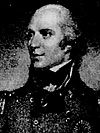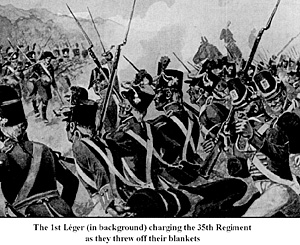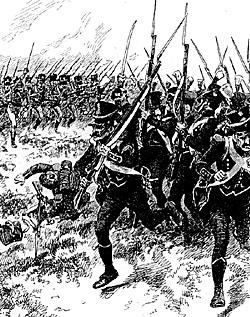Task Force To Calabria
Maida 1806
The French Field Guns Opened Fire
by K F Bailey, UK
| |
From an eye witness account by General David Stewart (at right) with the 78th Foot; "Two armies in parallel lines, in march towards each other, on a smooth and clear plain, and in dead silence, only interrupted by the report of the enemy's guns To the young Highlanders (78th Foot), of whom nearly 600 were under age (under 20 years and spoke only Gaelic), the officers, with very few exceptions, being equally young, and inexperienced, it was a critical moment... In this mutual advance, the opposing troops were in full view of each other . . . I have already noticed that the enemy's guns were not well served and pointed too high; not so the British. When our artillery opened, under the direction of Major Lemoine and Captain Dougal Campbell, no practice could be more perfect. Every shot told and carried off a file of the enemy's line ... The lines were fast closing, but with perfect regularity and firmness. They were now within three hundred yards distance, and afire commenced between the sharpshooters on the right, it was time to prepare for an immediate shock " Kempt had ordered his Light Brigade Into line and to unburden themselves of their greatcoats and packs. He ordered forward on his right the Corsican and Sicilian sharpshooters out to his flank on the left bank of the Lamato. As they advanced two companies of French skirmishers appeared from the scrub delivering a sudden volley which broke the Corsicans advance forcing them to fall back. Kempt sent forward his two right companies (Light Company 20th Foot and the "flankers" of the 35th Foot) who rallied the Corsicans and drove the French back into the scrub woodland but with the loss of Captain McLean of the 20th Foot. After their successful intervention the 20th and 35th returned at the double to the right flank of the Light Battalion.
The British held their fire and then advanced in a menacing red line to discharge three volleys at 150, 80 and 20 yards range, following this up with a shout of defiance and a determined bayonet charge by the light infantry. The French gave ground at once and turned to flight, burdened by their knapsacks they were soon caught by the Light Infantry and slaughtered. Compere was severely wounded having reached the British ranks and in his struggle was taken prisoner [General Compere's life was saved by Captain Tomlin of the 35th]. Sir Henry Bunbury, present in the field, wrote "Their 1st Legere advanced in line upon the brigade of British Light Infantry . . . A crashing fire of musketry soon opened the battle on both sides, but it was too hot to last at short a distance... Kempt gave the word, and his 800 Light Infantry pressed eagerly forward to close with their antagonists."
Acland's Brigade drew level with Kempt as the French 42nd Ligne came upon the flank of the 1st Legere, at this moment the 1st Legere received the volleys from Kempt's Light Brigade. General David Stewart recalls: "The lines were fast closing, but with perfect regularity and firmness They were now within three hundred yards distance... The enemy seemed to hesitate, halted and fired a volley. Our line also halted, and instantly returned the salute, and when the men reloaded, a second volley was thrown in.... As soon as the smoke had cleared our line advanced at the charge and the 42nd Ligne withdrew swiftly but not in confusion. They halted just in front of their second line, a constant running fire being maintained... " Ensign Joseph Anderson of the 78th Regiment, recalls and describes as follows: " . . . first with a volley from our brigade into the enemy's columns and from our artillery at each flank without ceasing, followed by independent firing as fast as our men could load; and well they did their work! Nor were the enemy idle; they returned our fire without ceasing, then in part commenced to deploy into line." At this point French cavalry tried to harass the 78th and 81st Foot and Acland ordered them to form square. Their charge was not brought home the Chasseurs returning to their own lines to fight on foot. The French Second line advanced upon Acland's Brigade, these contained De Watteville's Swiss in French service. Dressed in claret coloured uniforms and similarly dressed resembling the British Swiss regiment of the same name the Highlanders mistook them for their allies and ceased firing. The French Swiss encouraged by this slackening of fire advanced to within close quarters until the British realised their mistake and began to fire. Stewart rallied the 78th and led them forward in a charge, which drove back the French. Due to the confusion caused by the Swiss advance and a misunderstanding of orders the 81st almost left the field of battle if it were not for the prompt action of General Stewart. On the left wing of the British line, Cole's Brigade consisting of the 27th Foot and the grenadier companies reached the battlefield 15 minutes after Kempt and Acland had come into contact with the French. Major Roverea attached to Cole's Brigade observed " . . . on our side the combat did not go so well for us, for some sharpshooters had come close enough to incommode us with their fire. While my General was thinking that he ought not to allow some 'Flankers' to dislodge them, a shell exploded quite close to us and set fire to the dried grass of the field in which we were, and very soon the whole was in flames, and this caused some confusion in the centre of the 27th Regiment . . . At the same time a body of their cavalry advanced and threatened our flank and appeared to be about to charge. So much so that our mounted officers drew sword or pistol and prepared to defend themselves in the melee. Two companies of grenadiers who were moved from the right of the brigade to reinforce the left, suffered very much. A mass of infantry advanced behind the cavalry and the moment became critical for us. General Cole threw back three companies of the 27th with two of the grenadiers, and still the enemy advanced . . . " The 20th Foot commanded by Colonel Robert Ross, less its light company, had not landed with the main expeditionary force but had been allocated to large boats in the Bay of St. Eufemia to cruise off the coast as decoys to deceive the French about a possible further invasion elsewhere. On hearing the gunfire, without waiting orders, Ross gave directions for the Regiment to disembark and landed in haste. Henry Bunbury, Chief of Staff to Sir John Stuart, was expecting Oswald's brigade to move into the gap created between Cole and Acland. French marksmen were coming further and further around Cole's left flank when news reached Bunbury of the 20th Regiment's landing. Bunbury rode to meet them to explain the situation to Ross, in an instant the 20th pressed forward, drove the swarm of sharpshooters before them and gave the French cavalry such a volley they sent them off in confusion to the rear. Ross passed the left of Cole's Brigade, wheeled the 20th to their right and opened fire on the enemy's right flank. The effect was decisive. Reynier taken by surprise by the arrival of the 20th was unable to maintain his ground and withdrew his troops covering the retreat with horse artillery and sharpshooters. He left the plain and made his way up the valley towards Catanzaro closely pressed by the Light Infantry brigade as far as the town of Borgia. The victorious general marched his men back to the beaches to rest. He did not attempt to raise Massena's siege of Gaeta (Gaeta fell on the 18th). The troops and the order of battle had won the victory for the commander Stuart, once the firefight began; his personality had little influence on the fight, which was left much to the actions of his brigadiers. British casualties were light in comparison, 327 casualties, 44 men killed including 1 officer (Captain McLean), 13 officers and 269 men wounded. The French were not so fortunate more than 2000 killed, wounded or taken prisoner - (estimated at 930 killed, 1146 wounded). The AftermathAfter the battle, Stuart moved south to clear the peninsular of the remaining French garrisons at Montelone, Scilla, Cotrone. General Broderick arrived from Sicily with reinforcements and Reggio was captured. Lack of supplies, insufficient troops and the threat of malaria forced the main army to leave the mainland for Sicily leaving but a small garrison of 200 men at Scilla (which did not capitulate to the French until 17th February 1808). On the 29th July Sir John Stuart left Sicily for Malta en route to England to be replaced by Lt. General Henry Fox and his 2nd in Command Sir John Moore. ConclusionThe fact is it was British shock action the bayonet charge after volley and the timely emergence of Colonel Ross and the 20th Foot Regiment that won the battle of Maida. The French 'columns of division or d'assaut' were methods of manoeuvre before the final attack rather than an actual assault formation. Reynier's attempt to deploy into line before the clash of arms was misjudged and left too late having misread the intentions of the British troops when they halted in line to discard their greatcoats and knapsacks. BibliographyJohn Stewart Maida: A Forgotten Battle 1806
More Task Force to Calabria Other Maida: Back to Table of Contents -- First Empire #54 Back to First Empire List of Issues Back to MagWeb Master Magazine List © Copyright 2000 by First Empire. This article appears in MagWeb (Magazine Web) on the Internet World Wide Web. Other military history articles and gaming articles are available at http://www.magweb.com |

 Reynier's left wing advanced under the command of General Compere. The 1st Legere approached centre right in two battalion columns of companies, each of 7 companies, 1600 men, with a front of about 60 yards wide. Compere rode with his staff between the two columns marching at full speed at the pas de charge, Compere raising the tempo of his advance shouting "Ne tirez! Ne tirez! A la bayonette! A la bayonette!" The French columns attempted to form into line as recorded by Lieutenant Grisos, of the 1st Legere who wrote in 1828 "General Reynier gave the order to advance and engage the enemy, and in order to accomplish this to form on the left in line."
Reynier's left wing advanced under the command of General Compere. The 1st Legere approached centre right in two battalion columns of companies, each of 7 companies, 1600 men, with a front of about 60 yards wide. Compere rode with his staff between the two columns marching at full speed at the pas de charge, Compere raising the tempo of his advance shouting "Ne tirez! Ne tirez! A la bayonette! A la bayonette!" The French columns attempted to form into line as recorded by Lieutenant Grisos, of the 1st Legere who wrote in 1828 "General Reynier gave the order to advance and engage the enemy, and in order to accomplish this to form on the left in line."
 1st Legere break before the British.
1st Legere break before the British.